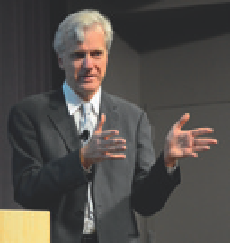Information Technology Reference
In-Depth Information
that Digital was not interested. Page and Brin got the same lack of interest from
other search-engine companies and from Yahoo!. However, Yahoo! cofounder
David Filo gave them some valuable advice: take a leave of absence from
Stanford and start their own business. By the summer of 1998, Page and Brin
had decided to take Filo's advice. They had a meeting with Andy Bechtolsheim
(
B.11.11
), one of the original founders of Sun Microsystems and now a Silicon
Valley investor in start-up businesses. Despite his concerns about the lack
of a viable business model for search engines in general, Bechtolsheim was
impressed by Page and Brin and, without any discussion of stock distribution,
he wrote them a check for $100,000, made out to Google Inc. Page and Brin had
to keep the check uncashed for two weeks until they had incorporated Google
as a company and opened a bank account.
Google's rapid rise to dominance in web searching is chronicled in detail
in
The Google Story
(
Fig. 11.25
) by David Vise. A company called Overture had pio-
neered search-related advertising, providing one of the first business models
for search engines. Despite their initial reluctance to embrace an advertising
model, Page and Brin decided to implement a variant of Overture's basic idea.
To maintain the integrity of their free search service, they insisted on keeping
their home page entirely free from advertisements and on distinguishing the
free search results from what they called “sponsored links.” Advertisers bid
in an online auction for priority placement in these sponsored links, which
appeared when users searched on specific search terms. Google only made
money when a user clicked on one of the ads displayed. By the year 2000,
Google was handling fifteen million searches per day compared to ten thou-
sand only eighteen months before.
Google's early breakthrough undoubtedly owed much to the idea of
including an importance score based on PageRank. However,
search engine opti-
mization
(SEO) companies have now become big business. These SEO compa-
nies advise advertisers how to ensure that their web pages will appear near
the top of search results. Some SEOs offer more than just good advice about
how to increase the advertiser's content and importance score. They also try to
manipulate the results using
web spam
, the practice of manipulating web pages
Fig. 11.23. The first Google production
server rack from about 1998. The rack
has multiple computer boards stacked
one above the other.
B.11.11. Andy Bechtolsheim, one of
the founders of Sun Microsystems,
was Google's first investor.
Fig. 11.24. One of the Google Data
Centers with tens of thousands of
computers installed on racks. The blue
light indicates that the servers are
running well.



Search WWH ::

Custom Search